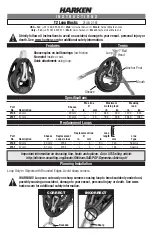
16
Model 273A Potentiostat/Galvanostat User’s Manual
eight Current Range Resistors. Values from 1
to 10M
can be selected, with the result that a
full-scale current (1 A to 100 nA) will cause a drop of 1 V. Since currents as high as two times full
scale are permitted on all but the 1 A range, drops as high as 2 V can occur. The circuit is
configured such that the Buffer Amplifier makes a four-terminal measurement of the voltage
drop across the Current Measurement Resistor, thereby assuring that the current measurement
is independent of cable and switch contact resistance in the switch and in the connecting cell
interface.
Differential Electrometer:
The Differential Electrometer is located in a remote enclosure to minimize lead capacitance. This
differential electrometer allows accurate potential control independent of lead and contact
resistance. The inverting (-) input of the electrometer connects to the working electrode ("top" of
the current sensing resistor), either directly, or via the sense lead if the remote sense is enabled
by removing the sense jumper and running a separate sense lead to the cell. The non-inverting
(+) input of the electrometer is normally connected to the reference electrode. Thus the output of
the electrometer is the potential of the reference electrode versus the working electrode, that is,
the parameter to be controlled in CONTROL E operation and measured in the CONTROL I
operation.
Control Amplifier (Power Amplifier):
This circuit is basically a ± 100 V, ± 1 A power operational amplifier. The various input signals
are applied through resistors (not shown) and summed together at the input of the Control
Amplifier. The output of the Control Amplifier is driven to whatever voltage is required to cause
the feedback signal to be equal and opposite to the summed input signals. The feedback signal
is an analog of either the cell potential or current, as determined by the E or I feedback switches
according to the operating mode. In the CONTROL E mode, the feedback signal is taken from
the electrometer. In the CONTROL I mode, it is taken from the current measurement circuit. The
Control Amplifier has computer-controlled frequency response, shown in the block labeled
STABILITY SELECTION. In both CONTROL E and CONTROL I operation, the HIGH STAB
mode limits the bandwidth of the Control Amplifier by changing the capacitor in its feedback
loop. This is done to assure stability on most routinely encountered cells and experimental
situations. The Control Amplifier is faster without these frequency adjusting components but may
oscillate under certain conditions.
Note that a Power Amp Monitor point is provided at the rear panel. To eliminate any shock
hazard, the amplifier's output voltage is internally divided by ten prior to being brought out to the
Monitor point.
3.2.5. Cell Switch and Relay
Referring to Fig. 3, note the Cell Switch and Cell Relay shown in series between the output of the
Control Amplifier and the counter electrode connection (red clip lead). Even though the block
diagram shows two switches in series, there are actually three of them. The first is the manually
operated CELL ENABLE Switch provided at the front panel as a fail-safe means of rendering the
red clip lead harmless. The second switch is a high-speed solid-state device and cell relay
capable of connecting and disconnecting the cell in less than one microsecond.
Although primarily intended to implement Current Interrupt IR Compensation, it is also used for
connecting and disconnecting the cell to provide "glitchless" transitions from Cell ON to Cell OFF
and vice versa. However, there is finite leakage across this solid-state switch when the cell is
OFF. Hence the third switch, the Cell Relay shown in the figure. Although this relay is much
slower than the solid-state switch, its low leakage assures a very high degree of cell isolation.
Both the manually operated Cell Enable switch and the computer controlled solid-state switches
(relay and solid-state switch) provide a feedback path for the Control Amplifier when the cell isn't
connected. The gain in this path is nominally X1 (solid state switch) or X1.5 (relay). If one volt is
applied, the Control Amplifier output will be 1 V or 1.5 V, as appropriate.
Содержание 273A
Страница 1: ...0RGHO 3RWHQWLRVWDW DOYDQRVWDW 8VHU V 0DQXDO 8VHU V 0DQXDO 3ULQWHG LQ 86...
Страница 6: ...vi Model 273A Potentiostat Galvanostat User s Manual...
Страница 10: ...4 Model 273A Potentiostat Galvanostat User s Manual...
Страница 23: ...Chapter 3 Characteristics 17 Fig 3 Model 273A Simplified Block Diagram...
Страница 26: ...20 Model 273A Potentiostat Galvanostat User s Manual...
Страница 66: ...60 Model 273A Potentiostat Galvanostat User s Manual...
Страница 70: ...64 Model 273A Potentiostat Galvanostat User s Manual...















































